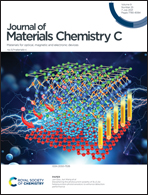Corannulene-based donor–acceptor-type conjugated polymers with electrochromic properties†
Abstract
π-Conjugated polymers have received increasing attention in electrochromic material research because their color change can be altered over a wide range by introducing electron-donor (D) and electron-acceptor (A) moieties. In this study, we have synthesized curved corannulene-based monomers with D and A moieties and applied them to prepare π-conjugated polymers to drive color switching. The absorption and emission properties of our conjugated polymers can be tuned by inserting D and A moieties into the conjugated backbone. Through this study, it has been demonstrated that corannulene-based conjugated polymers exhibit stable electrochromic properties with a high optical contrast ratio. Furthermore, emissions in the solid state and reversible electrofluorescence switching are observed in these polymers. This might be due to the inhibition of aggregation-induced quenching through the incorporation of nonplanar corannulene in the π-conjugated backbone. Based on these results, we consider corannulene-embedded π-conjugated polymers as a new π-conjugated system with versatile and tunable optical properties for application in modern optoelectronic devices.



 Please wait while we load your content...
Please wait while we load your content...